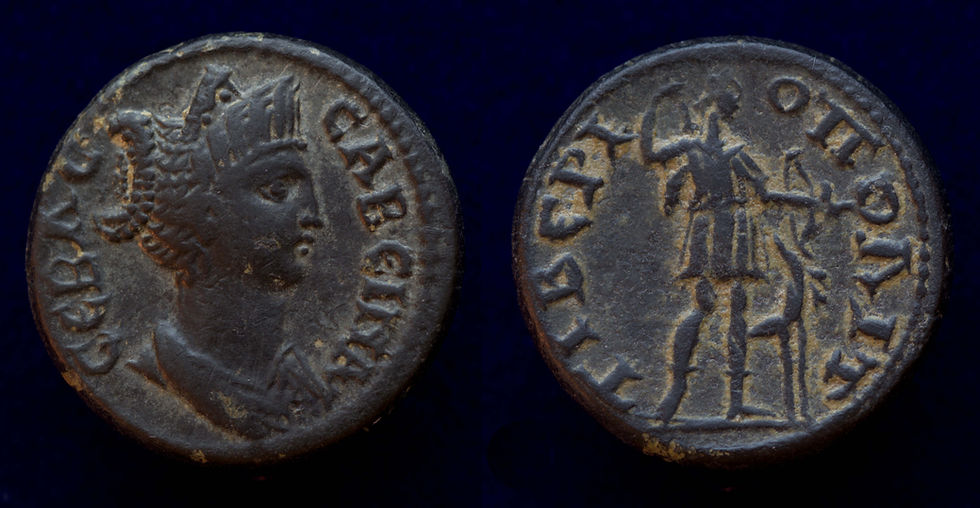Today's coin of interest comes from the reign of Hadrian (CE 117 to 138). This coin is issued in the name of his wife Sabina, from "Tiberiopolis" . Richard Abdy notes that Sabina was "the first Roman empress to have a sustained, regular production of coinage at Rome". Fae Amiro, in her 2022 PhD thesis, notes:
"Sabina was more plentifully represented on coins both at Rome and in the provinces than any previous empress. This is true in both percentage of total mint output and typological variety. There are also more extant sculptures of her than of any of the Flavian or Trajanic women."Both authors raise the conflicting evidence about the empress offered by the number of portraits and coins of Sabina vs. her low level of recognition or mention in literature. Her presence on coins shows that she at least played a more important role in the imperial messaging than is recognized by ancient authors. Hadrian also set a precedent that would be followed by his successors of issuing coins in the name of the empress.
This is one of the coins of Sabina from Rome - with a hair style that Amiro classifies as "queue" - the most plentiful on coins from Rome.

Roman Imperial, Sabina (128-137) AR Denarius (Silver, 19mm) Rome, 130-133
Obv: SABINA AVGVSTA HADRIANI AVG P P, draped bust to right, wearing stephane
Rev: CONCORDIA AVG, Concordia seated to left, holding patera and resting arm on statuette of Spes; cornucopiae under throne
Ref: RIC II Part 3 2501; BMCRE 895-900 (Hadrian); RSC 12
Historia Augusta 23.8 mentions the rumors that Hadrian drove her to suicide:
"He put many others to death, either openly or by treachery, and indeed, when his wife Sabina died, the rumour arose that the Emperor had given her poison."The rumors can be dismissed on the grounds that other sources do not mention this and Historia Augusta is often unreliable. Hadrian had her deified after her death.
The Apotheosis of Sabine from Arco di Portogallo in Rome. Image by Sailko, CC BY-SA 3.0, via Wikimedia Commons .
This coin comes from the Roman provinces and has an earlier hairstyle for Sabina that is called "crest and nest" or "nest",
Where is Tiberiopolis?

Roman Provincial Coins Phrygia, Tiberiopolis AE (Bronze, 4.59g, 19mm) Sabina (Augusta, 128-136/7)
Obv: CABЄINA CЄBAC, draped bust right Rev: TIBEPI-OΠOΛIT, Artemis standing right, holding bow and drawing arrow from quiver at her shoulder, stag at foot right.
Ref: BMC 12; SNG von Aulock 4028; SNG Cop 756
Note: The hairstyle is the most common on provincial coins and the earliest portrait type for Sabina with a braided circle of hair.
Several cities share the same name, Tiberiopolis:
Magie, D. (1950). "Roman rule in Asia Minor, to the end of the third century after Christ", Princeton, Princeton University Press, p.500.
This coin is from the Phrygian Tiberiopolis. Which David Magie notes a location in the upper Eğrigöz Çay a tributary of the Rhyndacus River:
Magie, D. (1950). "Roman rule in Asia Minor, to the end of the third century after Christ", Princeton, Princeton University Press, p.1359.
A Map
Three Ancient References
A location given by Ptolemy (c. 100 – c. 170 AD) Geography 5.2.25 "Tiberioupolis . 60°15' . 39°30' under Cities of Greater Phrygia"
A story of church succession from the late Roman Empire, Socrates of Constantinople (c. AD 380 – after 439) wrote:
Socrates of Constantinople, History of the Church, VII.46 tells a story of Paul Bishop of the Novatians "'If it shall please God that I should continue much longer in this life, restore me this deposit, now entrusted to your safe keeping. But should it seem fit to him to remove me, you will herein discover whom I have chosen as my successor in the bishopric.' Soon after this he died; and on the third day after his death, the paper having been unfolded in the presence of a great number of persons, Marcian's name was found within it, when they all cried out that he was worthy of the honor. Messengers were therefore sent off without delay to bring him to Constantinople. These, by a pious fraud, finding him residing at Tiberiopolis in Phrygia, brought him back with them; whereupon he was ordained and placed in the episcopal chair on the 21st of the same month."A location from Heraclis:
Hieroclis, Grammatici, Synecdemus, from a 1735 publication by Amstelaedami : Apud J. Wetstenium & G. Smith.Synecdemus, by sixth century, Byzantine, geographer Hieroclis, is dated to the reign of Justinian prior to AD 535, and it divides 912 cities in the Empire between 64 Eparchies. Tiberiopolis appears in Phrygia.
Numismatic References
Imhoof-Blumer does not reference this coin but does describe other coins of Tiberiopolis, with this minimalist description of the town.
"Tiberiopolis was a city of the Abbaitis, located between Ankyra and Aizanis in the headwaters of one of the tributaries of the Ryndakos."
- Imhoof-Blumer, Friedrich (1901). Kleinasiatische Münzen. Wien : Alfred Hölder Collection.This coin referenced by the British Museum:
Head, Barclay Vincent, 1(1906), Catalogue of the Greek coins of Phrygia, London, Brit. Mus. Collection
Domenico Sestini (1804) Descrizioni delle medaglie rare del Museo Knobelsdorffiano
Note that my coin above shows up with several variation in reverse legend - all different truncations of TIBEPIOΠOΛITΩN. The British Museum variant also found in Asia Minor Coins Online: Coin ID 12282
28 Examples are found with additional variations in the reverse legend, in Roman Provincial Coins (RPC) vol. III, 2519
Additional References
Sabina's coinage at the roman mint, Richard Abdy, Revue Numismatique Année 2014, 171, pp. 73-91.
Fae Amiro (2021), The Portraits of the Roman Empress Sabina: A Numismatic and Sculptural Study. McMaster University - Classics, PhD Thesis Advisor: Martin Beckmann.
Following Hadrian has interesting notes including this one on the Arco of Portugal that includes the Apotheosis of Sabina








Comments